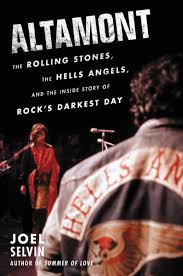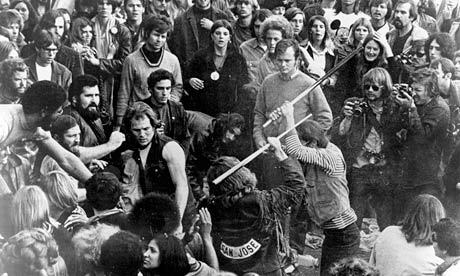
The infamous Altamont Speedway concert in 1969 was recognized as a turning point in the music scene, the hippie scene and the outlaw biker scene. It was a cultural shift from “The Summer of Love” to the dawning of “The evil hippie”, a branding that exposed the dark undercurrent running through the California rock music experience.
In a deeply researched new book, author Joel Selvin has gathered interviews with band members, spectators, police, medics and Hells Angels. This must be THE definitive account of the doomed free concert, and Selvin spares no detail in his quest to hear all sides of the story. In “Altamont – The Rolling Stones, The Hells Angels, And The Inside Story Of Rock’s Darkest Day” – Selvin corrects the illusion that The Hells Angels were fully to blame for the mayhem, something that is portrayed in the documentary “Gimme Shelter”, lending to the belief that Rolling Stones management was an innocent party. I cannot recommend this book enough, for those interested in any aspect of this event, but allow me to provide a summary.
In 1969 the Rolling Stones were in severe financial trouble. The plan was to run a large American concert tour to culminate in San Francisco at a free concert. This was an obvious attempt to coat-tail on the success of Woodstock, and the documentary movie that resulted from that music festival.
The concert was to be embedded in Grateful Dead territory, with the strong relationship between the Dead and the Frisco chapter of the Hells Angels playing an important role. The Angels, though ideologically different from hippie culture, were a staple in Haight-Ashbury street life and The Dead trusted them. Selvin writes: “the hippies saw the Angels as fellow rebels from straight society”.
In November The Rolling Stones were introduced to the Maysles brothers, Albert and David. They had been recommended to film the band at a meeting in L.A. before the Stones began the tour. Albert Maysles shot his first movie, about mental hospitals in the Soviet Union in 1955 as an extension of his work with a research project at Massachusetts General Hospital. That alone is very unusual and almost suggests an element of spy-craft. Another individual connected to the concert that was indeed tied to intelligence was attorney Melvin Belli, a celebrity lawyer who had at one time represented none other than Jack Ruby, the killer of accused Kennedy assassin Lee Harvey Oswald. Belli was basically there to lend bluster and to influence local arraignments. One more element must not be ignored; the concert was flooded with “bad” acid, at a time when the CIA was indeed attempting to drug a potential revolutionary movement.
Originally scheduled for Golden Gate Park, the concert promoters were forced to consider relocating to Sears Point Raceway outside Sonoma. That location would have worked well, with a thousand acres and easy freeway access. Hells Angel Terry the Tramp, a friend of the Grateful dead, warned that moving the concert would put it in the jurisdiction of a different chapter of The Angels – and the Angels had already been selected for security duty. Their pay was $500.00 worth of Beer.
When Sears Point Raceway officials saw the army of hippies and the chaotic method of piecing together the equipment and stage – they balked. A primary owner of the track, Filmways corporation (producers of “Green Acres” and “The Beverly Hillbillies”) demanded a $100,000 fee since the concert was going to be filmed.
Author Selvin makes it clear that much fault for the concert’s downhill slide lies with Mick Jagger, who refused to let any of the film’s profit go to Filmways. It was his decision alone – The Rolling Stones were broke, needed money and were anxious to compete with the Woodstock concert movie, also soon to be released.
While the wrangling over a concert location was being fought out, Dick Carter contacted attorney Melvin Belli and offered up his desolate Altamont Speedway as an alternative. With the proposed move to Altamont, the band lineup was The Grateful Dead, Santana, The Jefferson Airplane, Crosby, Stills, Nash and Young, and The Flying Burrito Brothers with Gram Parsons.The stage and lighting equipment were frantically moved from Sears Point to remote Altamont overnight.
Rival concert producer Bill Graham undermined the effort to have the Hight-Ashbury Free Clinic available at Altamont, so a rag-tag group of volunteers stepped in as medical staff. Early in the day overdoses were beginning to be a real problem, with bad LSD, amphetamines and lots of cheap red wine passed among the crowd. There were no food concessions, and only a handful of portable toilets available.
The Frisco Angels, known to the Airplane and The Dead showed up, but they were in the San Jose chapter’s territory. With them was a number of “unpatched” prospects, hangers-on that were determined to prove their mettle to the club. Other Angels were cooperative, providing escort for band members and helping in the medical tent. Things were starting to get really scary.
Author Joel Selvin makes the case that The Hells Angels did what they were hired to do – provide security between the bands, perched atop a mere 4-ft. stage, and 3000,000 drunk, tripping hippies. Selvin writes:
“The Angels had caused problems before, but this was a raging violation. The musicians had never had reason to fear. They felt immune from the real world when they were preforming. Nothing had ever penetrated that bubble before. It was an illusion kept in the best interests of both the musicians and the audience. This distinction was lost on The Angels“.
As the Angels cleared the stage area with fists and pool cues, the front edge of the concert became a combat zone. Selvin explains:
“These hippies had no defense against this kind of savagery”.
***
In all, four people died at Altamont. A young black man named Meredith Hunter made the mistake of trying to defend himself with a handgun and was stabbed to death by Angel Alan Passaro. Several people were run over by an acid casualty racing a car through the crowd and another drowned in a ditch. Marty Balin of The Airplane was punched-out on stage, and then again by the same Hells Angel in the medical tent.
Mick Jagger’s performance of “Sympathy For The Devil” set the stage for a “blood sacrifice” and all the bands withdrew into their music to emotionally shield themselves from the violence and fear. With themes like “Goat’s Head Soup”, Their Satanic Majesties”, “Let It Bleed” and “Sympathy For The Devil”, the Stones had been playing the occult card, but nothing had prepared them for Altamont. Selvin described it as “Conjuring the dark arts through simulated ritual”.
Selvin’s strong point is in his varied interviews that cover all the angles – with cops, medics, band members and concert casualties. He also provides a vigorous defense of The Hells Angels through their own words, from Angel President Sonny Barger and others.
Selvin clearly puts much of the blame for the ill-fated concert on The Rolling Stones, their management and Mick Jagger in particular:
“…that if Jagger had not insisted in keeping all of the money (ed.,from the film) the concert would have taken place at Sears Point”.
***
The concert is reproduced – somewhat out of order – in the movie “Gimme Shelter”. If you haven’t seen it before, you need to see it now.
In the aftermath, The Stones fled, leaving a trail of unpaid debts – to hotels, car rentals, travel agencies and other businesses. The movie did help Angel Alan Passaro in the court case regarding the Meredith Hunter stabbing, there is a scene in Gimme Shelter where Hunter can clearly be seen brandishing the handgun. Passaro was declared not guilty.
Selvin sums up the tragedy this way:
“But the long shadow of Altamont never disappeared. The concert grew in symbolic stature, coming to represent the end of the heady decade of the sixties that had reached a crescendo four months earlier in August with the massive Woodstock Festival, the moon landing, and the Manson killings all taking place within days of each other. Altamont was the coda. It was the stain that wouldn’t wash out of the fabric of the music”
This book is a must-read for rock fans, bikers or folks studying the sixties. It reads very well and moves along at a good pace, and now I’m interested in reading his “Summer Of Love: The Inside Story Of LSD, Rock & Roll, Free Love and High Times in the Wild West”.
——————————————————————-

For those who are interested, I wrote an article in 2013 that was about The Angels at Altamont, drawing on a large number of embedded resources. I was surprisingly close to Selvin’s account in his Altamont book, with a few other factoids thrown in. The link to that article is here:
-John Titus


A mostly true to the facts article as to what happened, generally, at this noise and violent event called a’concert.’
However, the description of the concert goers as ‘hippies’ is way off the mark.
Having long hair, dressing in colorful clothes and smoking pot did not in any way make the vast majority of the attendees at Altamont, or Monterrey or Woodstock hippies.
They were there because it was a ‘happening’ and to see some famous pop or rock bands.
The hippies I saw, and, at times spent time with, well, they were real and they did not go to these events to see ‘ego trippin’ and money hungry bands. The people that were at the ‘Haight’ in S.F. in ’67-69′ that I knew also discounted vehemently the other false assertion in this article that the hippies saw the bikers as any way brethren with whatever in common.